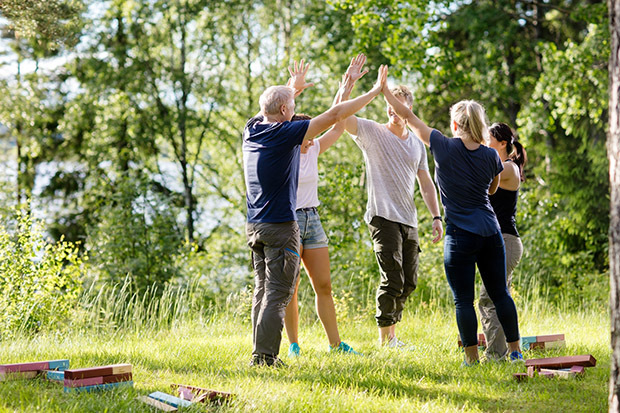Team building
These are some of the best team building ideas for your meetings.
![Co-workers giving high-fives after team building]()
Shrinking vessel challenge
If you've got more time on your hands and want your wellbeing activity to have more of a team building focus, we think that the shrinking vessel challenge is a great exercise. Not only does it give co workers the opportunity to problem solve, think outside the box, and collaborate on something that isn't purely work-related, but it also provides a mental break during typical working hours.
If you want more details about this classic team building activity, here's how it works. Identify a space on the floor with a blanket, rope, cardboard box, piece of tape or anything else you have on hand. It should be small, but big enough so that everyone can fit inside it easily. Then, continue to reduce the size of the space so that participants are forced to think of creative ways to keep everyone inside its boundaries.
This challenge is a great icebreaker so it would work well at the beginning of a long meeting, multiple days of conferences, or a series of professional development workshops.
Old fashioned egg drop
This is another classic team building activity that's perfect if you've got a little bit of extra time. Like the shrinking vessel challenge, it works well at the beginning of a multi-day meeting, workshop, conference or other similar event. This exercise is good because virtual teams can also participate and submit their entries by email.
It might seem cheesy, but the egg drop is a classic team building activity for a reason. It spurs creative problem solving, promotes team work, and can be a lot of fun.
If you're organising an egg drop challenge, you'll need to gather all sorts of creative materials from your office. Think newspaper, cardboard, tape, kitchen towels, rubber bands, pens, plastic wrap, and anything else you can think of. Then, divide your group into small teams and challenge them to build a structure that'll protect an egg from a two-story drop. Give them thirty minutes to complete the task.
Once the construction phase is finished, then comes the fun part. Take all the teams to a location where they can drop their structures (for example, into a parking lot) and put them to the test. To choose the winning team, investigate whose egg is in the best shape after the drop.











Share